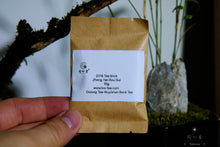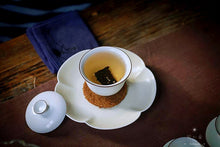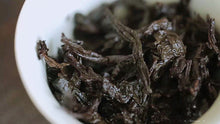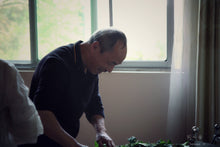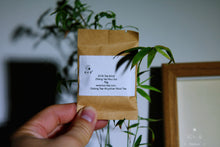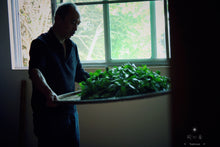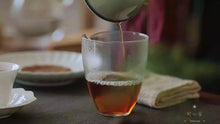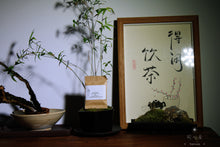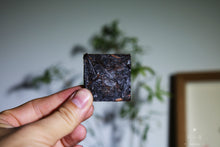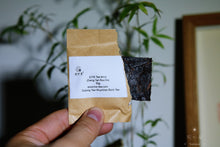
Recently, I like to keep thinking about some matters. Maybe I am starting to be nostalgic. Nowadays I start to feel more and more that if something is vintage, the more refined is its taste. When I went back to Wuyishan in late April to make rock tea, I visited Mr. Wang Guo Xing and had an aged tea Rou Gui tea brick made by him. The soup was smooth, sweet and mellow. I felt its effect on me for a long time. I was so surprised that I brought it back to my teahouse in Shenzhen and shared it with my fellow tea lovers. "Store a tea and it will become three times better, so everyone sells it aged the following year". Aged tea has been valued for a long time, and there is also a saying in Wuyishan that "tea aged for three years is medicine, after five years of aging it is a potent elixir, and after ten years of aging it is a treasure".This 2018 Rou Gui tea brick that I share with you was roasted and pressed into tea bricks in 2018, from tea leaves stored since 2015, so I call it: 2018 aged Rou Gui tea brick. Wuyishan rock tea pressed into bricks were first created by the "father of Da Hong Pao", Chen Dehua. (Because of lnstagram text limitations, I will write a detailed description of Wuyishan tea bricks in the comments section and on my website. Interested tea lovers are encouraged to read it.) In the Wuyishan area, most of the rock tea pressed into bricks for long term storage is composed of tea dust, leftovers etc. It can be used for medicinal purposes after a long period of time. This aged Rou Gui, however, is very unique, as the material used for it is high quality Rou Gui from Niu Lan Keng and Ma Tou Yan, together with some Huang Pian and Mao Cha. "It has the charm of an aged tea, in that as it is transformed over time, the taste is not quite the same each time you drink it. Usually aged rock tea roasted over strong fire has more or less the same taste as new tea. This tea has been beautifully transformed over the years. When I first tried it I wasn't instantly astonished by it, but it felt very smooth and comfortable. Slowly I became addicted to it. The aroma is sharper, but it is well contained in the soup. There isn't any taste of firing. It doesn't have that heavy flavour that some Rock Teas have. It is more mellow and smooth, with a sweet feeling and a pleasant hui gan (returning sweetness in the aftertaste). Each piece of a tea brick is 10g, and there are ten pieces in a full 100g brick. Visit my website www.txs-tea.com where you can also buy 10g pieces.
How to brew tea bricks:
1. Brewing method
1. Put a brick of tea in the utensils used
2. Pour boiling water into the utensils, spread over the tea bricks, wake up the activity of the tea, and stay for 60 seconds.
3. Gaozhuo is poured into boiling water and soaked for 20-30 seconds, the active molecules of the tea bricks will change, the tea aroma and taste will come out, and you can drink it.
Second, the pot boil drinking method
Choose a suitable boiling teapot, put in a tea brick, pour 500ml of cold spring into it, and boil it slowly until it boils. It can be repeated several times, and it will last for a long time. This method can make the tea aroma and taste more intense.
The two methods of drinking tea soup have different presentations in the front, middle, and end sections. This 2018 Rou Gui tea brick will become more colorful after being aged. It is also recommended for tea lovers to drink it now, and you may wish to collect some for a few years later. I believe that its charm is not only understood by old tea guests.
Wuyi rock tea generally appears in our lives in the form of loose tea, but as early as the 1990s, Master Chen Dehua was inspired by Pu'er tea pressing tea. After many experiments, he developed the brick of Wuyi rock tea. The new products of compacted tea in the form of cakes and cakes have been reviewed by authoritative institutions and experts, and the quality is consistent with loose tea. After being put on the market, they have aroused good response. The research and development of the new compacted products of Wuyi rock tea is the finished rock tea. Better preservation and ease of transportation open up new ways to better meet the different needs of the market.
In 1994, Chen Dehua went to Kunming to participate in the annual meeting of the Chinese Tea Society. Many shops in the local tea market displayed a variety of pressed teas, including bulk Pu'er tea. Among them, Xiaotuo tea has black tea, green tea and scented tea, but no oolong tea. At that time, I bought a little jasmine tuo tea from the market and brought it back. After brewing, the rich floral fragrance and the quality are very good.
He was inspired by this. At that time, his mind was constantly surging with plans to start trial production of oolong pressed products using Wuyi rock tea as a raw material, so as to fill the gap in the market where oolong tea was not tightly pressed.
According to the tea production background of Wuyi Mountain, there are at least two basis for the development of new compacted rock tea products that are in line with reality. One is that the initial production process of rock tea is not like Minnan Oolong tea. It is loose and straight, and the volume is fluffy. If it is made into compacted cake tea or brick tea, it is meaningful for convenient storage and transportation without affecting the quality.
The second is that Wuyi rock tea has many famous experts in history, and its quality after storage is significantly better than that of new tea: Zhou Lianggong, a celebrity in the Qing Dynasty, discussed the Wuyi rock tea "rain" in his "Min Tea Song". Although the past is good, it’s too new, and it’s hard to get rid of the irritation. It’s three times the price of a deep red, and every family shows off the next year.” And in ancient books, it is common to have a “fragrant and clear taste for Wuyi rock tea The classic evaluation of "mellow, sex and not cold, long-lasting is not bad".
In 1996, Chen Dehua talked to seniors in the tea industry about the idea of making oolong tea to squeeze the tea, such as Chen Lu, Zhang Tianfu, Ge Peizhen, etc., and they all wrote back. Professor Chen Lun wrote the calligraphy "Wuyi Rock Tea Dahongpao Tea Bricks" for Chen Dehua. After that, Professor Chen Lun introduced him and Dr. Lin Gang from Anhui Agricultural University contacted Su Fanghua, the Yunnan Foreign Trade Tea Company, and agreed to send Wuyi Rock Tea raw materials. Handed over to a tea factory in Kunming, processed into Xiaotuo tea, and then sent back to Wuyi Mountain.
There was almost no difference in the quality of the compressed Xiaotuo tea and the raw tea after the review. Chen Dehua offered to buy one of their machines to suppress Xiaotuo tea, but he did not get permission.
At the beginning of 1997, Chen Dehua was introduced by Su Fanghua to visit the Xiaguan Tea Factory in Dali. During the visit, he saw the pressing site of Tuocha (100g) and Tea Bricks (100-250g). During the visit, he deeply realized the value of intellectual property rights. Later, the development of Wuyi Yancha compact tea played a big role.
At that time, Chen Dehua had two considerations for the production of Wuyi Yancha to squeeze the tea bricks: one was that he failed to make a fool of himself, but it was only a personal behavior, which would not hinder the overall situation of Wuyishan tea industry; second, if he succeeded, he would not seek merit, but he would have nothing wrong, maybe in the future It can add some new products to Wuyi Rock Tea, so it is worth a try.
Fortunately, not only did he fail to make a fool of himself, but there were many people in the Wuyi tea industry who followed his approach... and even the tea area outside Wuyi Mountain. The first batch of products more than 1 ton was put on the Guangdong market that year, and some of them were subsequently approved for trial sales in the Hong Kong market.
The first batch of products were sent to Fuzhou for review and appraisal by experts from the province. They were tea master Zhang Tianfu, professor-level senior engineer of the Provincial Foreign Trade Tea Company, Lin Xinjiong, president of the Provincial Tea Association, and Zhan Zijin, a professor at Fujian Agricultural University, and tea from the school. Five experts including Guo Yaling, associate professor of academic review.
After review, the following consensus was reached: “Using Wuyi rock tea as the raw material, through the compaction process, the loose shape of loose tea bar tea is changed, which is conducive to packaging, storage and transportation. The product has a long shelf life, unique and innovative ideas, and is convenient for quantitative brewing. , Mellow scent, can maintain the unique style of Wuyi Rock Tea".
In the same year, the tea bricks pressed with cinnamon were also sent to the Anhui Commodity Inspection Bureau for review. They believed that “the brick shape, the shape is complete, the edges and corners are clear, the color is green and brown, the aroma is sweet cinnamon, it is longer, the taste is fresh and the aftertaste is sweeter, The soup is golden and bright, the bottom of the leaves are green and red, soft and even, and the quality is close to the control Rou Gui."
After 1998, 2500 kilograms of tea bricks have been produced successively. The major tea factories are vying to suppress compacted tea, and the development of compacted tea is flourishing. In 2014 and 2015, the processing volume of pressed tea in Wuyishan City reached an average of about 100,000 kilograms per year, and there was a phenomenon that Wuyi Yancha pressed tea was very popular.
Chen Dehua took 100 grams of tea bricks as a sample and divided them into eight pieces, each weighing 12.5 grams, half of which was more than 6 grams, and later changed into ten small pieces like "chocolate", which would be convenient for different consumers.
When designing the pressure at the beginning, the hydraulic cylinder of the tractor was used as a tool. One is that the pressure film groove is too shallow, the other is that the pressure is too small, and the third is that the constant pressure time is short, so the product is not beautiful enough and it is not easy to take tea. In order to press the floor tiles, the pressure is increased and the height of the mold groove is deepened. As a result, the product is beautiful and easy to take tea quantitatively, which has changed the old method of using a knife to pry the pressed tea.










